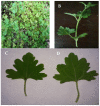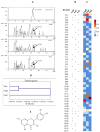Comparative Pharmacognosy, Chemical Profile and Antioxidant Activity of Extracts from Phania matricarioides (Spreng.) Griseb. Collected from Different Localities in Cuba
- PMID: 30558108
- PMCID: PMC6313911
- DOI: 10.3390/plants7040110
Comparative Pharmacognosy, Chemical Profile and Antioxidant Activity of Extracts from Phania matricarioides (Spreng.) Griseb. Collected from Different Localities in Cuba
Abstract
Phania matricarioides (Spreng.) Griseb. is a traditionally used plant with various pharmacological properties. However, there are only scarce reports about the phytochemistry and biological activity of this plant. In this work, P. matricarioides was collected from three different localities of Cuba: PmB (collected in Bauta, Artemisa), PmC (collected in Cangrejeras, Artemisa), and PmI (collected in La Lisa, Havana), extracted with aqueous ethanol, and analyzed macroscopically and microscopically. The extracts were screened for phytochemical contents, analyzed by TLC and HPLC, and screened for antioxidant activity using the FRAP and DPPH assays. Macroscopic analysis showed similar results for all samples; however, microscopic, physicochemical and phytochemical studies showed appreciable differences. In particular, the total solid of PmC extract was higher (1.94 ± 0.03%) than the other samples. In HPLC profiles, quercetin was identified in the three samples and a greater similarity between samples PmB and PmI was observed. All samples demonstrated radical-scavenging antioxidant activity by the DPPH assay, which PmC also demonstrated the smaller (p < 0.05) value (IC50 = 27.4 ± 0.1 µg/mL), but was statistically superior (p < 0.05) to vitamin C (IC50 = 23.7 ± 0 µg/mL). Also, in the FRAP assay, a higher vitamin C equivalent of PmC was significantly superior (p < 0.05) to the other extracts at the evaluated concentrations, which is likely due to a higher concentration of quercetin. In conclusion, P. matricarioides could constitute a potential resource in the field of phytotherapeutic products, and the results obtained can contribute to the development of the quality control norms for this species.
Keywords: DPPH; FRAP; HPLC profile; Phania matricarioides; phytochemical screening; plant extracts; quercetin.
Conflict of interest statement
The authors declare no conflict of interest.
Figures






Similar articles
-
Chemical Composition, Antimicrobial and Antiparasitic Screening of the Essential Oil from Phania matricarioides (Spreng.) Griseb.Molecules. 2019 Apr 24;24(8):1615. doi: 10.3390/molecules24081615. Molecules. 2019. PMID: 31022871 Free PMC article.
-
Phytochemical constituents and biological activities of different extracts of Strobilanthes crispus (L.) Bremek leaves grown in different locations of Malaysia.BMC Complement Altern Med. 2015 Nov 27;15(1):422. doi: 10.1186/s12906-015-0873-3. BMC Complement Altern Med. 2015. PMID: 26613959 Free PMC article.
-
Evaluation of Antiulcer and Antioxidant Activity of Barleria gibsoniDalz. Leaves.Pharmacognosy Res. 2016 Oct-Dec;8(4):226-230. doi: 10.4103/0974-8490.188879. Pharmacognosy Res. 2016. PMID: 27695259 Free PMC article.
-
Antioxidant activities and phytochemical constituents of Antidesma thwaitesianum Müll. Arg. leaf extracts.J Integr Med. 2017 Jul;15(4):310-319. doi: 10.1016/S2095-4964(17)60334-0. J Integr Med. 2017. PMID: 28659236
-
Phytochemical screening and evaluation of antioxidant activities of Dracocephalum kotschyi and determination of its luteolin content.Avicenna J Phytomed. 2016 Jul-Aug;6(4):425-33. Avicenna J Phytomed. 2016. PMID: 27516983 Free PMC article.
Cited by
-
Inhibition realization of multidrug resistant bacterial and fungal isolates using Coccinia indica extracts.Saudi J Biol Sci. 2022 May;29(5):3207-3212. doi: 10.1016/j.sjbs.2022.01.045. Epub 2022 Jan 24. Saudi J Biol Sci. 2022. PMID: 35844424 Free PMC article.
-
Chemical Composition, Antimicrobial and Antiparasitic Screening of the Essential Oil from Phania matricarioides (Spreng.) Griseb.Molecules. 2019 Apr 24;24(8):1615. doi: 10.3390/molecules24081615. Molecules. 2019. PMID: 31022871 Free PMC article.
References
-
- Jeffrey C. Compositae: Introduction with key to tribes. In: Kadereit J.W., Jeffrey C., editors. Families and Genera of Vascular Plants, Volume VIII. Springer; Berlin, Germany: 2007. pp. 61–87.
-
- Singh R., Singh G., Tiwari A.K., Patel S., Agrawal R. Diversity of host plants of aphids (Homoptera: Aphididae) infesting Asteraceae in India. Int. J. Zool. 2015;1:137–167.
-
- Mayara T.P., Del Castilo B.D., Serrão P.C.D., Lobato R.A.B., da Silva R.R., da Silva de A.S.S.M. The effect antioxidant aqueous crude extract in Acmella ciliata (Kunth.) (Asteraceae) J. Chem. Pharm. Res. 2016;8:651–657.
LinkOut - more resources
Full Text Sources
Miscellaneous

